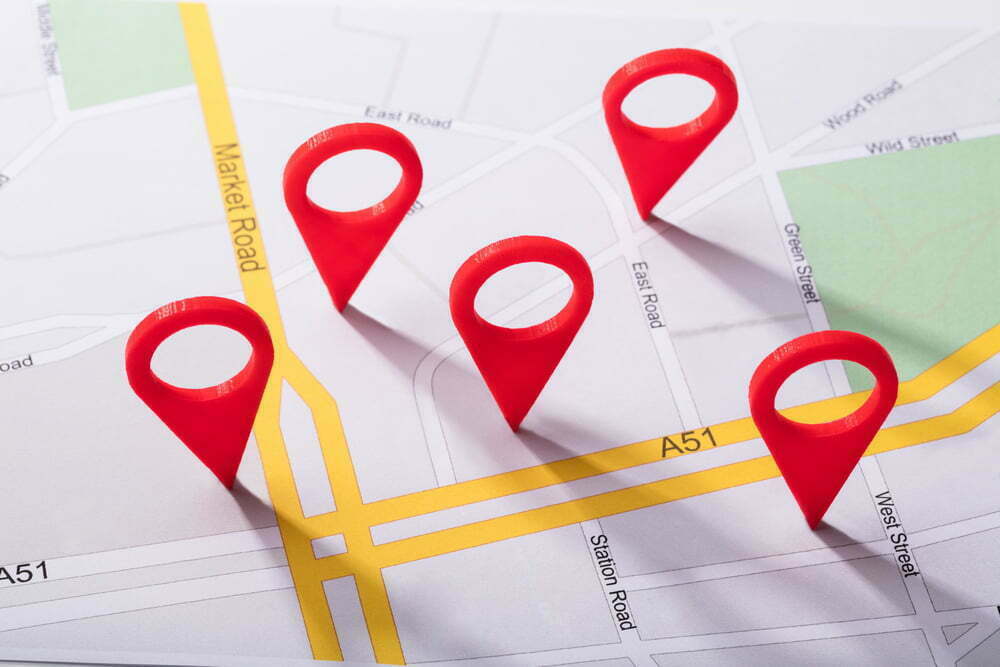You’ve seen it a million times. It’s a clickable snippet of text that links to a page. When you click it, the linked page opens.
In HTML, the code used for anchors is <a>—this is known as the anchor tag. Using this bit of code, you can anchor other code to an object. In 99.9% of cases, you’ll be using <a href>—anchoring a hypertext reference; or, in more common parlance, tying a website link to text!
In HTML, the link I included above would look like this:
<a href="https://en.wikipedia.org/wiki/Anchor_text">This is anchor text.</a>
The part that’s colored red? That’s the anchor text.
The internet as we know it today would not exist without anchor text. Links are one of the most vital parts of the internet—central to our ability to navigate to new pages. Almost all links are found within anchor text.
It’s no surprise that something so central to how we use the internet is an essential piece of the SEO puzzle. Search engines use anchor text, too—indeed, understanding which pages link to others is integral to Google’s algorithm. Google uses anchor text to determine context—both for the linking page and the page being linked to.
As you can imagine, this makes anchor text an invaluable tool that helps both humans and search engines understand your website.
In this guide to anchor text, I’m going to teach you:
- What the different types of anchor text are
- The role anchor text plays in optimizing your pages
- The history and evolution of anchor text
- How new technologies are impacting how we think of, use, and create anchor text
- The software I recommend for analyzing and developing anchor text and links
During this discussion, I’ll touch on a lot of different SEO-related subjects. While this guide should be approachable to those of you with little to no experience, you should know that the focus here is anchor text—not things like how to acquire backlinks or what your internal linking structure should look like. The tools and information I offer here should, however, help you better understand and develop both backlinks and internal links.
Now that I’ve anchored your expectations for this guide, let’s dive in!
The Different Types of Anchor Text
You probably already know about the different kinds of links. In SEO, there’s often talk about internal links (links from a page on a domain to another page on that same domain), backlinks (links from another domain to your domain), and outbound links (links from your domain to another domain). I’ll cover more types of links over the course of this guide.
What you may not know is that there are also many different kinds of anchor text. Let’s take a look:
Exact Match
Exact match anchor text is anchor text that exactly matches the keyword you’re trying to rank for. Here are a few examples:
“Disney World offers a number of different *anchor text* vacation packages *anchor text* ”
“StockX offers the ability to buy and sell *anchor text* trading cards *anchor text* ”
Exact match keywords are extremely useful, as they tell both users and search engines specifically what your page is about and precisely which keyword you’re trying to rank for. You’ll want to avoid using too many exact match anchor texts, however—Google can see that as spammy or bot-like behavior.
Fortunately, there are many other types of anchor text you can use.
Partial Match
Partial match anchor texts include part of (or even all of) the keyword you’re trying to rank for—but they’ll also include other partially related terms. Looking at our exact match examples, I can make partial match anchor texts with just a few adjustments:
- “Disney World offers a number of * anchor text* different family vacation packages *anchor text* ” (vacation packages is our keyword)
- “StockX is the place to*anchor text* buy and sell trading cards *anchor text*” (trading cards is our keyword)
Note that my partial match anchor text could easily be modified—Disney World’s anchor text might instead have been “deals on family vacations” Partial text doesn’t need to include the exact keyword you’re trying to rank for—just part of it. Generally, however, it’s best practice to include every element of the keyword you’re trying to rank for within your partial match anchor text.
Branded
Branded anchor text comes in two different forms. The first is generally used for linking to your homepage:
“Experience the magic of Disney World!”
“Buy and sell collectibles at StockX!”
The second type is sometimes called “Brand + Match”. These anchor texts are used to brand individual pages:
“Surprise your kids with a vacation at Disney World!”
“You can sell trading cards on StockX!”
Branded links will often be outbound—if people are already on your website, you probably don’t need to remind them. There are some edge cases, however, in which you’ll want to brand inbound links.
Generic
Generic anchor text is just that—bland, non-specific, and context-free.
“Click here to find out.”
“Get more information here.”
As you can imagine, generic anchor text is usually discouraged—you’re almost always better off finding a way to include keywords in your anchor text. I won’t tell you to never use it, but if you’re going to use it, I have an important tip for you:
Search engines and humans alike don’t just look at your anchor text without context—they read the surrounding words and sentences. By offering context clues around your anchor text, you’ll help everyone understand your link.
Image
Image anchor text isn’t really anchor “text”—it’s an anchor image. Take a look at what I mean:
Image anchors have largely fallen out of favor. There are a few different reasons for this:
- Images are more likely to be left unrendered/encounter other problems.
- It’s easy to forget to include descriptive alt text.
- Industry standards for alt text are different with anchor images.
The first point is pretty self-explanatory (would you click a link from an unrendered image?), but I’ll briefly cover the last two points:
Technically, the alt text for your anchor image includes the URL for the page you’re linking to. You should, however, also include descriptive alt text (as you would for any other image).
Here’s the tricky thing: Industry standards say that the alt text you include should describe the site the image is linking to, not the image itself. That’s pretty counterintuitive and can lead to your alt text including keywords that aren’t very relevant to your page. For these reasons, I tend to avoid image anchors.
URL
URL anchor texts contain the naked URL for the page you’re linking to. They’re generally used in citations.
- https://disneyworld.disney.go.com/
- https://stockx.com/
Obviously, you should almost never use these. It’s not the most attractive or descriptive anchor text (to put it mildly).
Long-tail
Long-tail anchor text is, essentially, partial match anchor text—but longer. This type of anchor text is pretty handy, as it contains a lot of context clues. You’ll still want to use it somewhat sparingly, however—anchor text that’s too long can look a bit unnatural.
“Plan a family vacation at Disney World!” (partial and branded and long-tail, oh my!)
“Sell your trading card collection online today!”
One of the most beneficial types of anchor text for local SEO is known as service-in-location or SIL. These long-tail anchor texts may even be exact matches for a long-tail keyword. For example:
“Call us for new solar panel installation in Milwaukee!”
Now that I’ve covered the different types of anchor texts and some of the contexts in which they’re used, let’s delve deeper into how anchor text affects SEO.
The Role of Anchor Text in SEO
As I mentioned at the top (and as you may have already known), links play an important role in search engine algorithms. When well respected websites and high authority pages link to other pages, the pages they link to are more likely to perform well in the SERPs.
This concept is known as link equity—sometimes, colloquially, you’ll hear the term “link juice”. The idea is simple—high authority pages (that’s what we call pages that Google respects and ranks high in the SERPs) pass some of their authority to the pages they link to.
Anchor text plays a vital role in this ecosystem—while the linking page gives Google context for how much equity to pass on to the link destination, the anchor text provides context for what the linked page is all about.
Imagine, for example, that you’ve got a page on sugar-free lollipops. You’d want both internal links and external links to your page to contain related keywords. “Sugar-free lollipops”, “Diabetes-friendly lollipops”, and “Xylitol lollipops” would all be excellent anchor texts.
“Sugar-free jelly beans” and “Very sugary lollipops”, on the other hand, would be terrible anchor texts. Even if they were coming from high authority sites, these links would only serve to confuse search engines about the topics your page is covering—and that could lead to drastic deranking.
Let’s get a little more specific about the role anchor text plays in SEO—I’m going to give you concrete use cases for anchor text in both backlinks and internal linking:
The Role of Anchor Text in Backlink Analysis
You can’t always control the types of anchor text that will appear in backlinks—links coming from other websites to your own, although when you’re guest posting, you’ll often have full control over your backlinks. When your site has been covered by news outlets or is being linked to independently by other websites, however, you’ll have less control.
No matter how you’re acquiring backlinks, you’ll want the anchor text for those backlinks to follow certain rules.
Best practices for selecting anchor text for backlinks
SEO tools like Semrush have backlink analysis tools to help you determine:
- Who is linking to you
- What anchor text they’re using in their backlinks
- Where you can get more backlinks
- The quality of your backlinks
- The quality of the anchor text associated with those backlinks
- And more
Indeed, Semrush classifies some anchor text as potentially dangerous. In particular, Semrush will alert you if it finds “Money keywords” (exact match anchor text) and “Compound anchors” (brand + match) as potentially dangerous.
These keywords are classified as potentially dangerous because they can look spammy—especially if you accumulate too many of them. This stems, at least in part, from an old black hat tactic called “anchor text spam” or “link text spam”. (I’ll cover this in greater detail in the History & Evolution section of this guide).
Basically, if anchor text matches your desired keywords too closely, it looks like it was carefully sculpted by an SEO—and that undermines the entire “unbiased links from authorities” part of Google’s algorithm.
To avoid being penalized, I recommend the following techniques:
- Ensure that the anchor texts linking to your site look natural
- Vary the kinds of anchor text that link to your site
- Don’t overuse exact match keywords
Obviously, you only have so much control over the anchor text used in backlinks to your site. Fortunately, most organically acquired backlinks aren’t an exact match or brand + match.
A note on nofollow
Does anchor text matter on nofollow backlinks?
Evidence points in two directions. Looking at Google’s algorithm, it’s unlikely that nofollow links have much of an impact at all on ranking—given how little weight nofollow links carry, I can pretty safely say their anchor text bears even less weight.
A good nofollow link will, however, attract more visitors to your site—and the more visitors your site has, the more likely it is to perform well in the SERPs. For this reason, I encourage you to follow best practices for all backlinks—even nofollow backlinks.
The Role of Anchor Text in Internal Linking
To succeed in the wild world of SEO, internal linking is a must. A solid internal linking structure can:
- Help search engines crawl your site
- Help search engines and users better understand your site
- Give search engine context for the relation between your pages
- Guide users through your sales funnel
- Help you to plan content and create site silos and clusters
- And more
All of the benefits I just listed are only possible if you use descriptive anchor text to give context to users and search engines.
One of my favorite examples of a site that uses anchor text to keep users engaged is TV Tropes. (Don’t click that link if you’re a nerd who doesn’t have any time to waste).
Its site is filled with internal links—it’s the whole point of the site. Every single trope you can imagine is linked to dozens of other tropes, which in turn are linked to dozens more. Here are some of the things you can expect from TV Tropes anchor text:
- They’re varied (partial match, exact match, and even image anchor texts are present)
- They’re descriptive (you’ll have a very good idea of the trope being linked to)
- They’re contextualized by the surrounding text
- The link destination is relevant to the linking page
TV Tropes is designed to keep users on the site for long periods of time—and the anchor text of its internal links plays an important role in helping accomplish that goal.
You should create anchor text that follows all of the above points as part of your internal linking strategy. Unlike TV Tropes, however, your internal linking structure may have a final goal in mind—the page where you convert readers into customers.
Some people are incredibly good at including relevant, descriptive, and colorful anchor text right up until it’s time to make a sale—then they turn to “Click here to buy our stuff!”. I recommend thinking of anchor text like you would think of copy—keep it concise, interesting, and attention-grabbing.
Tips for selecting relevant and descriptive anchor text
Here are a few tips for improving the anchor text you use on internal links:
- Avoid generic anchor text.
- Focus on partial match anchor text.
- Keep your anchor text relevant to both the link destination and the linking page.
- When constructing silos or clusters, keep anchor text relevant to the silo or cluster you’re building.
- Keep anchor text enticing—don’t be afraid to get creative!
- Using keywords you’re trying to rank for is fine—but don’t keyword stuff.
- Using SIL keywords is often a good idea when linking back to your homepage in local SEO.
The History & Evolution of Anchor Text

Anchor text has been around for a long time—HTML has been around since 1990, and the anchor tag <a> has always been an integral part of the system. You can see it in the first publicly available document listing HTML tags (albeit in a slightly different form).
It’s no surprise, then, that anchor text has always been relevant to Google—even back in the day when media outlets may very well have called links by their “full” name, hyperlinks. (Things were fun back then. Following hyperlinks to travel the information superhighway. Very hype. Very cyberpunk.)
Since its inception, Google has used links to determine the trustworthiness and rank of a site. Indeed, the PageRank algorithm (the origins of which you can find to this day in a paper Sergey Brin and Larry Page wrote at Stanford) is almost entirely based on how pages link to one another.
In the paper I linked, you’ll see that, even originally, Google put a heavy emphasis on anchor text. I’m quoting the paper directly, now:
“The text of links is treated in a special way in our search engine. Most search engines associate the text of a link with the page that the link is on. In addition, we associate it with the page the link points to. This has several advantages. First, anchors often provide more accurate descriptions of web pages than the pages themselves.”
A good idea, in principle, and one I’ve recommended you keep in mind at several points in this article.
The problem with this methodology is that Google placed too much emphasis on anchor text in the early days. This led to a practice known as Google bombing, in which sites would intentionally link to pages with irrelevant anchor text in order to influence search results. At one point, the top result for “more evil than Satan himself” was the Microsoft homepage.
Obviously, Google didn’t let this kind of behavior slide. Several updates since the dark days of Google bombing have limited the relevance of anchor text in determining what queries a site ranks for. Google’s algorithm now also focuses on the quality of the content available on a page, the quality of backlinks, and an incalculable number of other factors.
These updates (most notably, Panda and Penguin in the early 2010s), have kneecapped black hat SEO efforts (thank goodness), and rewarded efforts to make high-quality content. Instead of buying and trading links, Google now rewards links that are earned the hard way—organic links.
As such, natural and varied anchor text is now the gold standard—exact match text looks sketchy. Different writers take different approaches when linking to the same page—diverse and descriptive anchor text is the way to go.
That’s not to say that some link-building efforts can’t happen by force. Acquiring links through directories is still a great idea (especially for SEO), though these links will often be URL links and thus offer less high-quality anchor text. Location-specific anchors have also become a boon for local SEO—and now that we know the history of anchor text, we’re well-primed to take a look at how it affects local SEO.
The Importance of Local SEO & the Role of Anchor Text in Local Search Rankings

I’ve already talked briefly about service-in-location (SIL) style anchor text. Thinking about it more deeply, you’ll see that SIL anchor text meets a lot of the criteria I’ve been discussing:
- They’re (most often) partial match anchor text.
- They often describe the linking page and link destination.
- They can easily be varied in style.
- They’re often topically relevant to the surrounding text.
Best of all, they tell Google (and your users) exactly which locations you operate in and what services you offer.
For these reasons, SIL anchor texts have become a gold standard for local SEO. I use them often—many of the pages in the silos and clusters of content I build for local businesses will link back to the homepage using SIL anchor text.
Best practices for using location-specific anchor text
- Use location-specific keywords: City, region, and even street name can all be used.
- Use phrases and keywords that are relevant to the location and/or the industry. You might, for example, use “best solar panels in the Greater Milwaukee Area” or “solar panel installation and repair in Wauwatosa”. Remember, the text surrounding your anchor text is relevant, too!
- Don’t overuse location-specific text—natural-looking internal links are a must, too.
The Impact of Emerging Technologies, Such as Artificial Intelligence & Voice Search on Anchor Text

How emerging technologies will affect anchor text isn’t entirely clear. Google’s algorithm is incredibly complex, and while we know that anchor text plays an extremely important role in how and when a website ranks, telling you precisely how that role differs in text searches and voice searches is somewhat challenging.
Here’s one thing I can say for sure: Voice searches are much more likely to be local searches: it’s often much easier to say, “Hey, Google, find a coffee shop near me” than it is to type the request. As such, SIL anchor texts are even more important in the brave new world of voice search.
Understanding the impact of AI on anchor text is even more difficult—it depends entirely on what AI you’re talking about. Mostly, AI has served to benefit SEOs in developing better, more natural links and anchor text.
That brings me nicely to the next topic.
Analyzing Anchor Text With Software
There are several different SEO tools that can help you analyze your internal links and backlinks—and these tools can also help you analyze your anchor text. I’m going to highlight four of these tools to give you an idea of how software and AI can help you improve your anchor text:
Using Semrush

I’ve already touched on how Semrush analyzes anchor text. It’s part of their Backlink Audit tool, found under the “Anchor” column. Semrush will describe the type of anchor text, using categories like “Money”, “Compound” “Organic”, “Naked” and “Other”.
Anchor texts that Semrush considers suspicious (Money and Compound anchors) will be highlighted in red to alert you. Bear in mind that a few money or compound anchor texts aren’t the end of the world (though too many can look unnatural). The authority (and toxicity) of the linking domain are also relevant.
Using Ahrefs

Ahrefs has an excellent tool for anchor text analysis; you can find it in the Backlink Profile section of Ahrefs. Given that its site is named after the <a href> code I’ve talked so extensively about, it’s no surprise that its anchor text tool is killer.
The Anchor tool tells you exactly which anchor text is being used for backlinks to your site. The tool is automatically sorted so that the most commonly used anchor text is at the top of the list.
You can get a lot of useful info from this tool—everything from the percentage of a given anchor text that’s made up of dofollow links to exactly which referring domains are using a given anchor text. Ahrefs also includes empty anchors in its list, as well as the top Domain Rating (its score for a site’s authority) that a referring domain using a given anchor text has.
I know I just gave you a lot of information about the tool, but that’s honestly just scratching the surface. It’s super intuitive, and I highly recommend you try it.
Using Majestic
Majestic is a tool designed specifically to check backlinks. When you use its anchor text checker, it sorts the anchor text of inbound links from most popular to least popular, in much the same way Ahrefs’ Anchor tool does.
There are a few things Majestic offers that Ahrefs does not, however. You can see not only what anchor texts are being used, but what topics the pages using those anchor texts are usually covering. Further still, you’ll get a Trust Flow (Majestic’s authority score) average for the topic being covered.
Majestic is great for discovering the topics being covered on pages that link back to yours, and can help you assess guest posting opportunities and more.
Using Link Whisper

Every piece of software I’ve brought up so far helps you manage the anchor text of backlinks.
Link Whisper is different—it helps you build a comprehensive internal linking strategy. Link Whisper will automatically detect places where links to existing content seem viable—in other words, it automatically detects text you could already use as anchor text, then provides recommendations for which pages to link to.
You can also adjust the anchor text that it’s recommending you use. Link Whisper is the best internal linking automation software on the market; I highly recommend you read my full review.
FAQ
Q: How does the use of anchor text in sponsored or paid links differ from its use in organic or editorial links?
A: Generally, sponsored and paid links should follow the same structure as organic and editorial anchor text—make it look natural, and opt for partial matches. What matters more here is ensuring that the sponsored links you get are from legitimate sources. Additionally, you may find that branded links are more natural in sponsored content, so don’t be afraid to use them!
Q: How does the use of anchor text in internal linking compare to its use in external backlinks in terms of SEO impact?
A: Both are extremely important, and I urge you not to neglect either one. The difference is largely in the type of anchor text that will be used. One might argue that the anchor text of internal links is more important because you have more control over the type of anchor text that will be used, while external backlinks are more likely to be naked or branded. Optimally, however, you’d have control over both, and you’d use a combination of almost every type of anchor text for your backlinks.
Q: Are there any differences in the use of anchor text between mobile and desktop devices, and how does this impact SEO and user experience?
A: Mobile devices are more likely to be used for local queries—that’s one of the reasons that SIL anchor texts are so valuable for local businesses. Check where your traffic is coming from, and consider optimizing your anchor text for mobile-friendly queries when necessary. Mobile queries tend to be short and sweet, while desktop queries are more likely to be long-form.
Conclusion
Understanding how to use anchor text is vital to your success in digital marketing and SEO. In this article, I’ve strived to provide everything you need to know to write killer anchor text that will boost your rank.
Of course, all of this knowledge of anchor text is basically useless if you don’t know how to build backlinks and internal links, so I encourage you to learn as much as you can on those topics.
I’d also highly recommend you try the tools I mentioned above—they’re great for link building and analysis, including anchor text analysis.
Go forth, and always remember—when you’re well anchored, it’s easy to see the horizon, even in the stormiest of seas.



Leave a Reply
You must be logged in to post a comment.